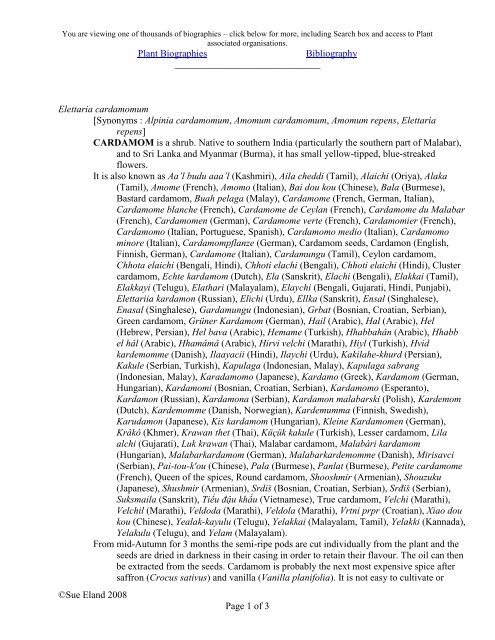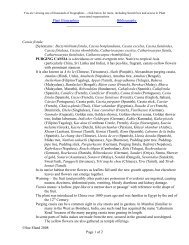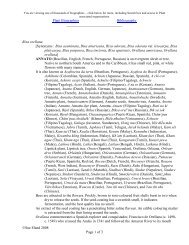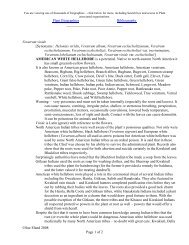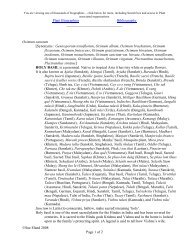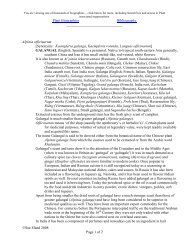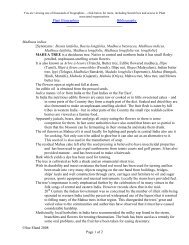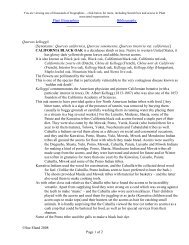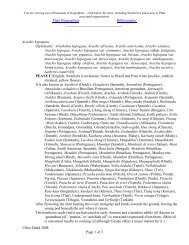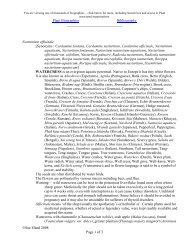cardamom - Plant Biographies
cardamom - Plant Biographies
cardamom - Plant Biographies
You also want an ePaper? Increase the reach of your titles
YUMPU automatically turns print PDFs into web optimized ePapers that Google loves.
You are viewing one of thousands of biographies – click below for more, including Search box and access to <strong>Plant</strong><br />
associated organisations.<br />
<strong>Plant</strong> <strong>Biographies</strong><br />
Bibliography<br />
______________________________<br />
Elettaria <strong>cardamom</strong>um<br />
[Synonyms : Alpinia <strong>cardamom</strong>um, Amomum <strong>cardamom</strong>um, Amomum repens, Elettaria<br />
repens]<br />
CARDAMOM is a shrub. Native to southern India (particularly the southern part of Malabar),<br />
and to Sri Lanka and Myanmar (Burma), it has small yellow-tipped, blue-streaked<br />
flowers.<br />
It is also known as Aa’l budu aaa’l (Kashmiri), Aila cheddi (Tamil), Alaichi (Oriya), Alaka<br />
(Tamil), Amome (French), Amomo (Italian), Bai dou kou (Chinese), Bala (Burmese),<br />
Bastard <strong>cardamom</strong>, Buah pelaga (Malay), Cardamome (French, German, Italian),<br />
Cardamome blanche (French), Cardamome de Ceylan (French), Cardamome du Malabar<br />
(French), Cardamomen (German), Cardamome verte (French), Cardamomier (French),<br />
Cardamomo (Italian, Portuguese, Spanish), Cardamomo medio (Italian), Cardamomo<br />
minore (Italian), Cardamompflanze (German), Cardamom seeds, Cardamon (English,<br />
Finnish, German), Cardamone (Italian), Cardamungu (Tamil), Ceylon <strong>cardamom</strong>,<br />
Chhota elaichi (Bengali, Hindi), Chhoti elachi (Bengali), Chhoti elaichi (Hindi), Cluster<br />
<strong>cardamom</strong>, Echte kardamom (Dutch), Ela (Sanskrit), Elachi (Bengali), Elakkai (Tamil),<br />
Elakkayi (Telugu), Elathari (Malayalam), Elaychi (Bengali, Gujarati, Hindi, Punjabi),<br />
Elettariia kardamon (Russian), Elichi (Urdu), Ellka (Sanskrit), Ensal (Singhalese),<br />
Enasal (Singhalese), Gardamungu (Indonesian), Grbat (Bosnian, Croatian, Serbian),<br />
Green <strong>cardamom</strong>, Grüner Kardamom (German), Hail (Arabic), Hal (Arabic), Hel<br />
(Hebrew, Persian), Hel bava (Arabic), Hemame (Turkish), Hhabbahân (Arabic), Hhabb<br />
el hâl (Arabic), Hhamâmâ (Arabic), Hirvi velchi (Marathi), Hiyl (Turkish), Hvid<br />
kardemomme (Danish), Ilaayacii (Hindi), Ilaychi (Urdu), Kakilahe-khurd (Persian),<br />
Kakule (Serbian, Turkish), Kapulaga (Indonesian, Malay), Kapulaga sabrang<br />
(Indonesian, Malay), Karadamomo (Japanese), Kardamo (Greek), Kardamom (German,<br />
Hungarian), Kardamomi (Bosnian, Croatian, Serbian), Kardamomo (Esperanto),<br />
Kardamon (Russian), Kardamona (Serbian), Kardamon malabarski (Polish), Kardemom<br />
(Dutch), Kardemomme (Danish, Norwegian), Kardemumma (Finnish, Swedish),<br />
Karudamon (Japanese), Kis kardamom (Hungarian), Kleine Kardamomen (German),<br />
Krâkô (Khmer), Krawan thet (Thai), Küçük kakule (Turkish), Lesser <strong>cardamom</strong>, Lila<br />
alchi (Gujarati), Luk krawan (Thai), Malabar <strong>cardamom</strong>, Malabári kardamom<br />
(Hungarian), Malabarkardamom (German), Malabarkardemomme (Danish), Mirisavci<br />
(Serbian), Pai-tou-k'ou (Chinese), Pala (Burmese), Panlat (Burmese), Petite <strong>cardamom</strong>e<br />
(French), Queen of the spices, Round <strong>cardamom</strong>, Shooshmir (Armenian), Shouzuku<br />
(Japanese), Shushmir (Armenian), Srdiš (Bosnian, Croatian, Serbian), Srđiš (Serbian),<br />
Suksmaila (Sanskrit), Tiểu đậu khấu (Vietnamese), True <strong>cardamom</strong>, Velchi (Marathi),<br />
Velchil (Marathi), Veldoda (Marathi), Veldola (Marathi), Vrtni prpr (Croatian), Xiao dou<br />
kou (Chinese), Yealak-kayulu (Telugu), Yelakkai (Malayalam, Tamil), Yelakki (Kannada),<br />
Yelakulu (Telugu), and Yelam (Malayalam).<br />
From mid-Autumn for 3 months the semi-ripe pods are cut individually from the plant and the<br />
seeds are dried in darkness in their casing in order to retain their flavour. The oil can then<br />
be extracted from the seeds. Cardamom is probably the next most expensive spice after<br />
saffron (Crocus sativus) and vanilla (Vanilla planifolia). It is not easy to cultivate or<br />
©Sue Eland 2008<br />
Page 1 of 3
harvest. The best quality is considered to come from rainforests off the Malabar Coast<br />
(where it is called elettari) followed by good quality <strong>cardamom</strong> from Mysore, Sri Lanka,<br />
Aleppi and Madras. Seed pods from other members of the ginger family, particularly<br />
round cardamon (Amomum compactum), can be offered as <strong>cardamom</strong> but they are<br />
considered to be inferior. Black seed pods (which have a strong flavour) will have been<br />
sun dried, while green seed pods (which have a milder flavour) will have been dried in<br />
large kilns.<br />
Warning – prolonged handling of the seeds can cause dermatitis and can make skin more<br />
sensitive to sunlight.<br />
Cardamomum is said to be a Greek name for an Indian spice, kardamon.<br />
In ancient Greek and Roman times the meaning of the word ‘<strong>cardamom</strong>’ seems never to have<br />
been consistent as merchants (and thus everyone else at that time) used it for one spice or<br />
another or a group of spices which could vary in content from one market to another.<br />
Over time in Europe the word has settled on Elettaria <strong>cardamom</strong>um. But sympathy must<br />
be extended to modern historians who have to unravel its early historical details from<br />
highly confusing records. Facts such as its progress into the Mediterranean and Europe<br />
are uncertain and the following information is offered on that understanding.<br />
Before the early Centuries AD <strong>cardamom</strong> was a common spice throughout India used<br />
particularly in hotly-spiced sauces – and was no longer limited to its native habitat in the<br />
south of the Country and neighbouring areas further south still. It had penetrated beyond<br />
India’s northern borders as in ancient Egyptian times the seeds were chewed there to<br />
whiten teeth. Cardamom was being imported by the ancient Greeks by the 4 th Century BC<br />
and is referred to by Pedanius Dioscorides, the 1 st Century Greek physician, in his De<br />
materia medica. It was also being imported by the Romans by the 1 st Century AD. Both<br />
the Greeks and the Romans filled shells with a mixture of <strong>cardamom</strong> and wax as a<br />
perfume worn in their hair or on their clothing. This was a fashion that persisted for<br />
several centuries not least among some of the Christian clergy who were being berated<br />
for it in the 4 th Century by the Italian scholar and Latin Church father, St. Jerome (c.342-<br />
420). In addition the use of <strong>cardamom</strong> for dental hygiene had not been confined to the<br />
Egyptians as the Europeans also found the taste of garlic (Allium sativum) was<br />
neutralized if the <strong>cardamom</strong> seeds were chewed after a meal.<br />
By the Middle Ages <strong>cardamom</strong>, then often called Amomum, had penetrated more northern<br />
areas of Europe. It was to be found in some of the kitchens of the rich where the cooks<br />
used it for flavouring and, with other foreign spices, was a sign of prestige. Apparently it<br />
was far more popular in England than France and records show that while Jean le Bon<br />
(1319-1364) of France, who had been taken prisoner at Poitiers in 1356 by Edward the<br />
Black Prince (1330-1376), was held at his cousin’s home in England awaiting payment of<br />
the requisite ransom <strong>cardamom</strong> was one of the spices included in his household expenses.<br />
At the turn of the 20 th and 21 st Centuries it is the Swedes who consume the most<br />
<strong>cardamom</strong> in Europe. They are said to account for one quarter of India’s output.<br />
More recently in the Middle East it has been used as a flavouring in coffee (in Iran particularly)<br />
and in mulled wine. In Arabian countries, especially where cardamon coffee is offered as<br />
a symbol of hospitality, <strong>cardamom</strong> is believed to be able to enhance digestion and for<br />
good measure act as an aphrodisiac. In India <strong>cardamom</strong> has long held its reputation for<br />
being an aphrodisiac, and the sugar-coated seeds feature in Hindu festivals and<br />
ceremonies.<br />
Ground <strong>cardamom</strong> is primarily used as a spice. It is a significant ingredient in Eastern as well<br />
as Scandinavian cookery. (In Malaysia it is chewed with betel nut, Areca catechu.) These<br />
Middle Eastern and Eastern flavouring practices are beginning to gain popularity on other<br />
Continents, including North America and Europe. Here not least in parts of South<br />
©Sue Eland 2008<br />
Page 2 of 3
America <strong>cardamom</strong> can now be found added to coffee, tea (or chocolate too) on occasion.<br />
Pol Pot (1926-1998), the military leader of the devastatingly cruel Khmer Rouge movement in<br />
South-Eastern Asia who was held personally responsible for more than 2 million deaths<br />
in Cambodia in the 1970s, came from a Khmer race. Known as the Pohls, the Khmers<br />
live in the Cardamon Mountains of Cambodia and are descendants of freed royal slaves.<br />
Their lives have been spent harvesting <strong>cardamom</strong> from the forest or from small cultivated<br />
areas. It is such a significant part of their life that the rhythm of their religious festivals<br />
has been determined by the growth cycle of the shrub. Sadly their poverty has long been<br />
emphasized by the contrast in price the dealers have paid them for the seeds compared<br />
with that ultimately demanded in the market place.<br />
Cardamom can be used as a flavouring to disguise the taste of medicine. (In classical times it<br />
was one of the at least 36 ingredients used by Mithridates (c.132-63 BC), the 1 st Century<br />
King of Pontus (northern Turkey), in a poison antidote (known as Antidotum<br />
Mithridaticum or Theriac) which he took daily to acquire an overall immunity – an<br />
important consideration if it is remembered that he gained his position of power by<br />
poisoning his opposition.)<br />
Today the essential oil is a commercial ingredient used by the perfumery industry particularly<br />
in some eau de colognes. It is also used by the food industry as flavouring in cakes,<br />
gingerbread, sausages, pickles and curry powders. The drinks industry uses the oil as<br />
flavouring in cordials, bitters and liqueurs, and it also provides a commercial flavouring<br />
forthe pharmaceutical industry in proprietary medicines.<br />
Medicinally, it has been used locally in India and some other Asian countries to treat<br />
depression, some heart disorders, dysentery and diarrhoea. It has also been used to<br />
counter vomiting and nausea. Where <strong>cardamom</strong> is easily accessible it is believed by some<br />
that its over-use could cause impotency. On the other hand a daily dose is said to<br />
maintain general health and improve eyesight.<br />
©Sue Eland 2008<br />
Page 3 of 3


